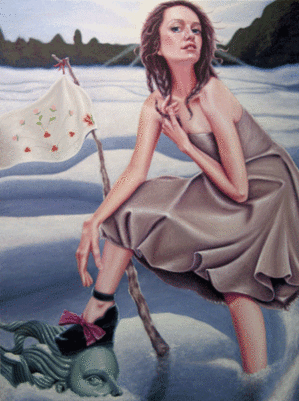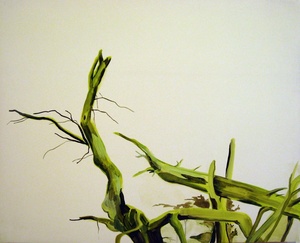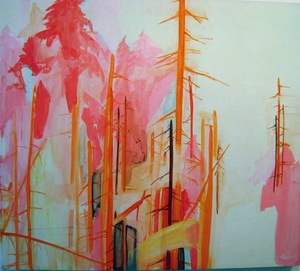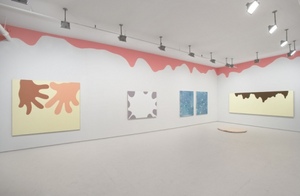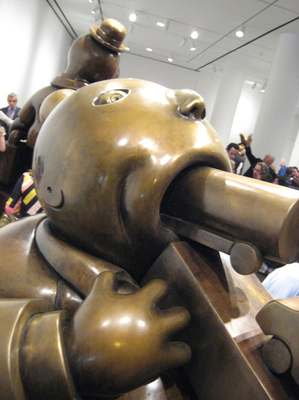This is an archive of the ArtCat Zine, 2007-2009. Please visit our new project, IDIOM.
Recently by Olympia Lambert
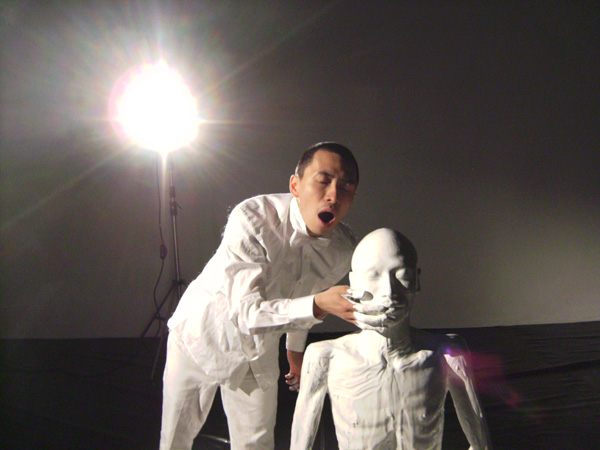
Olympia Lambert recently corresponded with artist Terence Koh on occasion of his participation in KKK, a three-person exhibition curated by Javier Peres and opening later this week at Mary Boone Gallery. --B.B.
Olympia Lambert for ArtCat: Hi, Terence. As your three-person Mary Boone exhibition fast approaches with the delectable fellow K's-- Koons and Kelley -- I'd like to ask you the following questions. Feel free to add additional commentary if you choose. My own opinion of you is ever-changing. When you told me you like when "people get over what they assume who I am to who I think I really am," it opened up a whole new way in which I perceive you, as well as your body of work. As an artist, are you specifically making it with an audience in mind, or is that audience yourself? Considering for a moment the second option, do you think this is why it's so difficult for people to understand the "real" you?
Terence Koh: i make art for other people. being an artist for me is for the better of society and the better of history. and it's always been the same individual, me as terence koh that does this. i doo what i doo what comes naturally. i am a servant to history. and i want to leave the world more beautiful through what i doo. and there are so many ways to express love, so there are so many "me's" to do that cause the world is all so different so have to be so many different facets of ambassadors.
AC: What exactly does your new sculpture entail for the KKK show, and what is its point of reference in terms of the progression of your body of work over the past decade?
TK: it is a 21 ft porcelian urinal that has been smashed up and reglued again. i don't tink i have been able to get any progress into my work though i have been trying. nothing seems to be getting better.
AC: Given the challenges in the economy, where do you see monumental art fitting in, given the continuing downturn in the art market?
TK:i find it difficult to answer most of your questions so far. all art is monumental. just as all art is spectacular and gigantic. the economy is just like waves in the ocean but it doesn't really affect the sea cause its still the sea. i do not mean to be poetic in this answer but its the closest answer i can know how to express for your question.
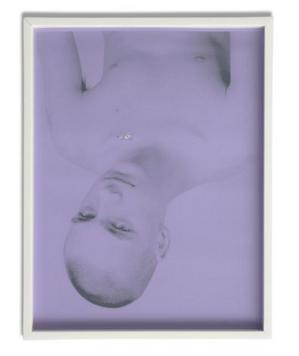
AC: Many of your works have at their core a makeup of degradable material -- blood, sweat, tears, semen, corn syrup, powdered sugar. Do you think of your work in terms of a correlation to their eventual decomposition, or is there no time line to what you feel they will represent?
TK: we have a contract when people buy my artwork that if the artwork changes it is the intention of the artist. and that is the truth. i always have flowers around my house and i like it when they shrivel up and die. i never throw away any of my flowers, i keep all of them in boxes. they are still equally as perfect as the day they were cut and died.
Dangerous Women
DFN Gallery - 210 Eleventh Avenue , Sixth Floor, New York NY
24 July - 29 August
Don't trust that woman
Don't trust that woman, boys
'Cause she'll burn you
Turn you into little toys
-Elton John
Ah, July: midway through the 2008 -- post Mileygate, post Hillary, post “Kristen,” (who prompted the “Spitzer? I hardly knew her!” ) Breathing a breath of fresh air into a topic desperately in need of some CPR, the intriguingly titled group show, Dangerous Women at DFN Gallery comes to our rescue. The exhibition is a raucous, brilliant display of what is and is not considered safe with society's ever changing definition of femininity. The artists involved also challenge preconceived notions of the pursuit of the feminist Holy Grail: that of the self-defined woman.
In her painting New Day, Alison Blickle seems to channel every girl's inner Patricia Field, having her erstwhile explorer triumph over the buried Grecian goddess beneath her, balancing her velvet embossed platform heels -- with bows to boot -- on a frozen body of water. But is this a female Sir Edmond Hillary, raising her flag in conquest, reaching the pinnacle of success or the white flag one of surrender? For the image Blickle is evoking is that of a sexed up fashion plate, eager to showcase her wares for her next victim. Is she a complacent player in the “What Not to Wear” generation of feminism, or is there more beneath the surface? I loved this piece for its challenge of initial perception. My own jury's out on if she's a harbinger of victimization or heroism. The come-hither expression, with bottom lip agape, looks more akin to Mischa Barton than to any championing of feminist thinking. It's an interesting juxtaposition -- the comely beauty, triumphant on solid frozen footing -- for the frozen river the subject stands upon seems as storied as the millennial glaciers. But last this reviewer checked, the glaciers are melting.
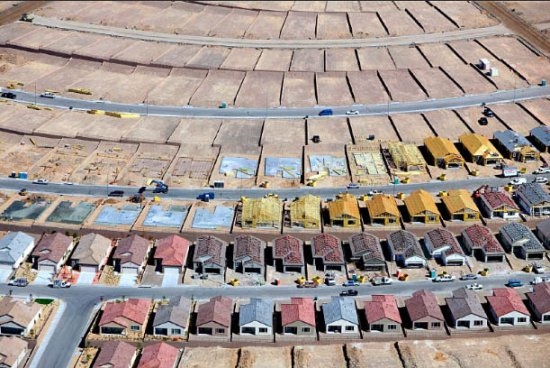
Market Forces Part I (of II): Consuming Territories
At Carriage Trade Gallery through Sunday, May 18th.
5 April - 18 May 2008
Note: Part two of this exhibition will be on view from 23 May - 9 June 2008.
Artist lofts. Think about that term for a second. When was the last time you saw an artist buy an artist loft apartment?
Walk down any block in New York, and you'll understand. No matter the developer or ad agency responsible, there it is on the scaffolding of another high rise: "Luxury artist lofts." Taking a moment to deliberate, one has to wonder if there is anything out there to purchase but luxury.
Just recently installed at Carriage Trade gallery in Soho, Market Forces Part I: Consuming Territories is a poignant commentary on how these words of commerce have been taken out of their historic confines and assigned radical new meaning. Today, artist lofts rarely house working artists, but are deliberately marketed to give the look and feel of bohemian grottoes. Add to it the redefinition of art itself – no longer a vessel of human creation or transference of beauty; there is nothing left to ponder, but only to possess. In the Market Forces exhibition, we're asked to consider if we are, or have ever been, truly free? This show serves as a cautionary tale of the present day voracious societal norm of living beyond one's means, and a harbinger of further devolution still to come.
With the completion of Manifest Destiny, growth has now turned inwards. An obliteration has occurred – yards, trees, sidewalks, being able to walk to school. Much of what was once commonplace in communities has forever vanished before our eyes. Take Alex MacLean's almost Google Earth-like aerial photographs of planned communities in various stages of development. Appearing almost like a crowded cookie sheet, or container of Marshmallow Peeps, each home is meticulously spaced just feet apart from the next. In the photo of Las Vegas, they look as if they're being built close enough for a resident to open a window and shake a neighbor's hand. An Orwellian story come to life, these planned communities give up any sense of uniqueness to the design of the home itself. There is no room for eccentricity, let alone individuality. At the same time, despite that these designs are carbon copies of each other, the cookie cutter offerings are nonetheless marketed to the buyer as "theirs to own." Viewing the desolate plots of desert land and cloned candy-shell roofs from above shows how hollow the promise rings. The continued notion of home ownership is incredibly deceitful, for no one is truly a homeowner unless they have paid every cent of the cost. MacLean is not only warning the viewer of a loss of self, but also highlights the downfall of a credit-based society lying dormant and complacent, sleeping in their 300-thread count sheets, happily sedated by their Lunesta, snoring away, all the while believing the lie. This photo in particular shows the harsh reality. The modern day lords of the land (the banks) are the real owners — a singular image of the new feudalism.
Amy Vogel
Larissa Goldston Gallery - 530 W. 25th St, New York NY
29 February - 29 March 2008
On initial viewing of Amy Vogel's “World Go One Way, People Another,” currently on view at Larissa Goldston Gallery, I was greeted with that sense of tranquility that comes from a storied Sunday drive down a meandering country road. Majestically tall old growth trees reach to the heavens; highly saturated harmonizing colors proliferate in multiple cross-hatched water-laden strokes, showcasing a breadth of naturalist access to a jaded urbane existence. But these are not back roads leading to a vacation home for mid-summer. They are inroads to a realm entirely foreign to the numbed city dweller, completely accustomed to the erosion of privacy in daily life.
Throughout Vogel's work, sweeping brushstrokes reveal multi-layered saturations of acrylic color, looking almost watercolor-like in nature. But a pile of logs is not necessarily all that it appears to be. Take Untitled 2008. In this piece, layers of contrasting green give a luminescent glow to a collection of lumber, bringing forth a sheen not unlike the dermis of our Martian counterparts. The logs lie in a disjointed heap, bracing against each other for support. The craggy branches reach out like spindly tentacles, looking for their next victim. It seemed a bit Blair Witch to me: will anyone hear you scream in the woods? I looked closer. Sure enough unseen on a first glance, there, tied to the base of the structure, is a rope knotted into a perfect noose. Gothic sensibility at its finest. Next time one encounters such a trail marker, they may think twice before resting their weary bodies upon its sturdy timber.
Another fascinating object of reference that appears throughout Vogel's craftsmanship is her insertion of mobile homes lying amidst depictions of the rural blue collar of Upstate Michigan. There's certainly no Matthew McConnaugheys (read: celebrities) vacationing in Airstreams here. These are homes of residents that are a recluse's dream come true. A trailer lies at the bottom of a lavender and leafy crimson ravine, a single door leading to open air. A spare tire lies long abandoned next to the aluminum doorway; a protective barbed wire fence lies at the edge of the property. But is this truly a protection from the dangers of nature, or that of outsiders?
Vogel's work aims to romanticize the simplistic, but looking at these images I didn't feel that these were “bucolic settings” by any means. There's an extremely sad, lonesome quality at play here. Somewhere along the way, a connection, has been severed. The residents use the rural setting as an attempt to provide a stable refuge in an increasingly unstable world. But the trees, on several second looks, no longer appear to be majestic pines reaching to the heavens, but perhaps victims of forest fires. They appear singed by leaping flames, their remains standing as skeletal remnants of the dry season.
Throughout Vogel's works the viewer must constantly look downhill towards the focal point of reference. In several of the pieces a curved rail from the highway looks from above at a journey below. The pictures evoke the feeling of being at a zoo, looking at the trapped animals beneath us. The subject is continually at a safe distance — never too close, but yet far enough to succeed in its isolation. The trees continually provide what seems to be protection, but not from the elements, but intruders. Vogel has gifted us with our own VIP invitation inside a world not necessarily interested in otherwise letting us in. An intimately intriguing show, Amy Vogel, “World Go One Way, People Another” is on view through March 29th.Carl Ostendarp, 1987 - 2007
Elizabeth Dee Gallery - 545 W. 20 St, New York NY
1 December 2007 - 12 January 2007
I walked into Elizabeth Dee transfixed not only by the works hanging on the walls, but the transformation of the space itself. With the top edges of the walls oozing pastel-hued candy pink paint drips I was transported back to a limited recollection of the pre-school phenomena — mud pies in the backyard, cooking apple sauce for the first time, little boys running to the bathroom with pants down, leaking all the way onto milk-vomit covered floors.
Childhood is all about an inundation of bodily fluids, and as we grow older we attempt to immerse ourselves in forgetting about them, or perhaps more or less acknowledge they're there, but not letting them dominate our memories.
In Carl Ostendarp's work, the artist quietly references the body's makeup and its processes through pop culture abstraction; body-like fluids take on a cartoonish quality with the flatness of his paint application. This retrospective of the artist's work currently on display offers a unique look at the his development in this regard since the late 80s.
The Public Unconscious
Tom Otterness
Marlborough Gallery - 545 West 25th Street, New York, NY
4 October - 3 November 2007
"He killed a dog, you know."
These words eerily echo through the cavernous chambers of my mind as I start this review. Can you separate the person from the artist? Is it possible to take work for face value without considering the artist?
Early on in the career of sculptor Tom Otterness, he was just another struggling young artist here in Manhattan trying to make it. In the era of the ever-escalating shock value and competitive one-upsmanship of his time — Christopher Burden’s getting shot on camera certainly comes to mind — one of Otterness‘ early pieces involved the adoption of an innocent little mutt, which he then took home and shot dead with a rifle, filming it as it took its last breaths. The video's title? “Shot Dog Piece”.
Art? I ask myself. More like playing God and serial killer at the same time. Fast forward three decades — the Otterness of later years takes center stage at a new Chelsea exhibition, The Public Unconscious.
The show's title touches on how soon we forget the genuinely disturbing actions of the young artist producing abject performance, how that young artist became the Otterness of the mainstream, and perhaps a more general comment on the current disarray in American politics. As an awkwardly coinciding penance, perhaps, this past Friday saw Mr. Otterness go from a former Alphabet City dog murderer to a children's playground sculptor at a dedication ceremony in Manhattan's Lower East Side. His commission was a whimsical frog creature for the kids of the neighborhood to play on.
Can Otterness' current record of public sculpture coerce us into forgiving him, or is his current success a play-by-play book of "Karma Restoration 101?" So now the Gandalf-tressed intellectual of Gowanus has been made accessible to all, via an explosion of the public art commissions that have helped increase his profile and created the Otterness public art brand. He’s even designed a Humpty Dumpty balloon (fashionable stovepipe hat included) for the Macy’s Thanksgiving Day Parade. One really can’t get any more connected to the general public than that.
ZINE
HOME
TIPS / COMMENTS
CATEGORIES
CONTRIBUTORS
- Greg Afinogenov
- B. Blagojevic
- Adda Birnir
- Susannah Edelbaum
- Julie Fishkin
- Paddy Johnson
- Jessica Loudis
- Christopher Reiger
- Andrew Robinson
- Peter J. Russo
- Blythe Sheldon
- S.C.Squibb
- Hrag Vartanian

